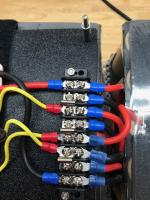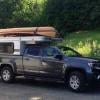It has been about a year since I built this battery pack, so I wanted to give a quick update. I have camped ~30 nights using the lithium pack, but I have also left the fridge and fans running in the camper for a good part of the summer - so I would estimate the equivalent of 60 nights of use. In that time there have been no issues, with the deepest discharge around 60Ah (or down to about 60% SOC).
I was working on a camper project this weekend so I took the opportunity to run another capacity test on the camper battery. This was similar to the first test I ran right after building the pack (which yielded 150.3Ah) but I ran the discharge rate slightly lower at 7A, just in case the battery had degraded. After 20 hours at 7 A (so 140Ah), the battery was still > 12V under load, and jumped back up to 12.4V once the test completed, indicating to me that there was at still at least some capacity left. In retrospect, I should have run the test at 8A rate, but from what I can see the battery is still performing the same as it did last year.
Over the last year the pack has stayed in balance to within ~0.1V per cell, but I did activate the balancer once or twice, mainly just because I could.
I have made a few minor changes to my setup since first installing the battery:
1. I reduced my charging voltages - float is now 13.2V (really just offsets the loads), and my bulk charge cuts off at 13.6V. This probably only charges the battery up to 90% SOC, but that is still more than enough power for me. It should also keep the battery in balance longer.
2. Victron has added a remote battery temperature/voltage monitor to their lineup. This, coupled with a firmware update to the MPPT solar controllers, allows you to set a minimum charge temperature (3C in my case) so as to avoid the issue with charging below freezing. You can also view the battery temperature on the Victron app on your phone. In the winter I leave my ACR isolated when driving, and check the battery temperature before switching on the ACR. Low temperatures have not really turned out to be an issue - we keep the camper well above freezing when we are using it - so the only time it has ever been a concern is on the first day of a trip when the camper has been in the driveway unheated overnight and we are going to drive first thing in the morning.
So far this project has been an unqualified success, but I will try to remember to update this thread again in a year or so with how the system is holding up.
Edited by rando, 16 September 2018 - 09:48 PM.


















